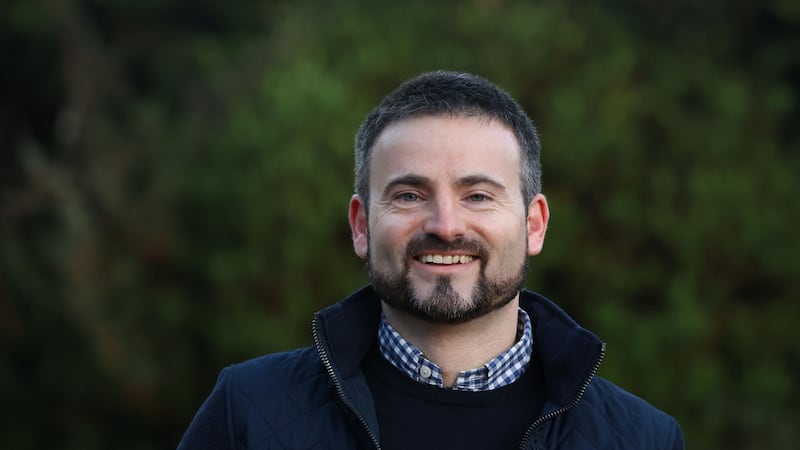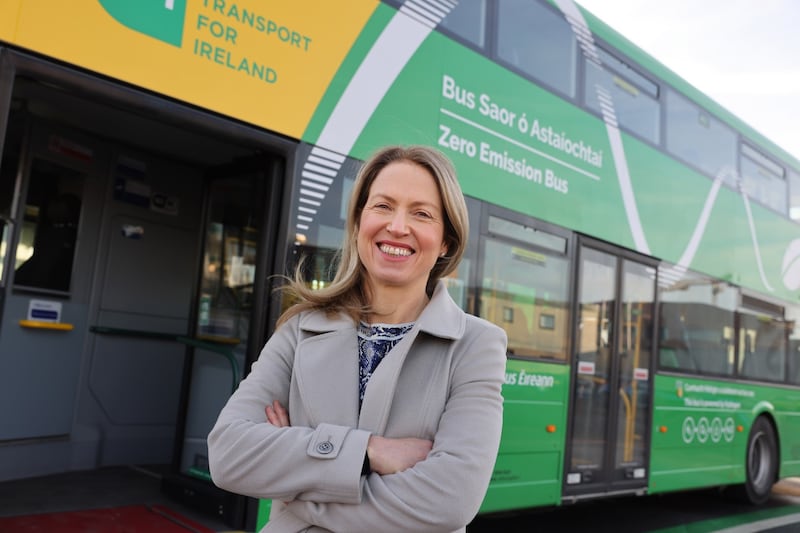Every evening the 105x bus leaves UCD heading for Fairyhouse in Co Meath. On first impression, there is an absence of a guttural diesel roar as it departs silently from Belfield campus. However, it’s not quite an Electric Vehicle (EV) and there are almost imperceptible puffs of steam coming from the back.
The steam exhaust indicates the bus is powered by hydrogen, one of just three in CIE’s fleet of 2,063 buses.
Hydrogen is hardly a new source of power. Until now, however, it has been considered trickier, more expensive, more complicated and more dangerous than fossil fuels. A big reason is because it doesn’t occur naturally, produced instead by separating hydrocarbon into its elements, or else by electrolysis (using electricity to isolate hydrogen from other elements).
A historic red flag points to its dangers. It is the Hindenburg disaster of 1937. The German-made Zeppelin used hydrogen gas but caught fire when docking in New Jersey, killing 37 of its passengers in an accident that was reported across the globe.
Ireland has more potential for wind and ocean energy than almost any country in the world
But now its role may be substantial in the post-fossil-fuel era, especially in the transport sector. As an energy source it is still at a nascent stage in Ireland. Over the next decade, however, so-called "green hydrogen" is going to become a major component of Ireland's energy sector. Currently there is a bewildering array of research being done on how to produce it cleanly, how to store it, how to transport, and how best to employ it.
Last week, Mercury Renewables announced it was investing €200 million in a combined wind power and “green hydrogen” project in Co Mayo. It is one of dozens of similar ventures in the pipeline all along the west coast.
James Carton’s first introduction to hydrogen came in secondary school in Co Wexford. In 1997, he entered the Young Scientist competition by deconstructing his dad’s lawn mower and converting it to a hydrogen-powered machine. He was hooked. His PhD, unsurprisingly, was on hydrogen. Now, he is assistant professor in energy sustainability and hydrogen at DCU.
For Rory Monaghan, it has been a similar path. As an undergraduate in NUI, Galway he was asked to do a term paper on fuel cells. “I had no idea what they were. I did a bit of digging,” he said. That brought him to hydrogen. Eventually he did a PhD at MIT in Boston exploring hydrogen technology. Now he’s back in NUIG as senior lecturer in energy system engineering.
Carton and Monaghan are the academic prophets for hydrogen’s potential use in Ireland. Both are passionate about their specialist subject.

So why all the sudden excitement about hydrogen in Ireland? The proposition is set out clearly by each.
For one, Ireland has more potential for wind and ocean energy than almost any country in the world.
No other county can match County Mayo. 'In the wind industry they talk about Mayo being offshore and onshore. It's on land but given the geology and meteorology, the wind resource is as if you are at sea'
“We have this terrific natural resource and a huge territory,” says Carton. He puts the potential into perspective. “You could put Germany in our territory three times. Yet the entire island has the population of a city elsewhere.”
Over the next decade Ireland’s wind energy sector is going to expand hugely, in particular with the introduction of floating turbines to harness offshore wind. It will produce far more than our population will need.
Even now, when it’s blowing, wind produces too much for the national grid to handle. Besides, the grid is not developed sufficiently in the places where the biggest winds and seas are found – along the western seaboard.
The solution? Electricity created by wind can be used to split water by electrolysis into its component parts of hydrogen and oxygen.
“Once you have the hydrogen you have a storable form of energy,” says Monaghan. “Every one hundred units of electricity (created from wind) you can transform into 70 units of hydrogen.”
So there’s a 30 per cent loss but that’s infinitely better than having nothing. It’s also clean with no fossil fuels involved, thus the term “green hydrogen”. The gas produced is compressed to a high pressure and can be stored. In time, Ireland could become a major exporter of hydrogen energy.
Besides Mercury Renewables there are plans for perhaps a dozen major "green hydrogen" production facilities. These include the ESB's "Green Atlantic" project at Moneypoint, Co Clare; a massive 2 Gigawatt plan for Valentia island; a big hydrogen plan in Aghada in Cork which is being progressed by the energy company EIH2. There is talk of others in Killybegs, Foynes, and in Galway Port.
But no other county can match County Mayo. Both Monaghan and Carton similarly describe Mayo’s peculiar characteristics.
“In the wind industry they talk about Mayo being offshore and onshore,” says Monaghan. “It’s on land but given the geology and meteorology, the wind resource is as if you are at sea.
“The electricity grid is not at the moment capable of handling that amount of wind potential.”
Carton says that six or seven other companies are developing plans for green hydrogen sites in Mayo alone. However, most of it will not begin to happen at scale until the end of the decade at least, he says.
And that brings us back to the buses. Hydrogen is converted back into energy by a process that is the reverse of how it is separated in the first place. Hydrogen is combined with oxygen across an electrochemical cell to produce electricity, water and a little heat. That’s where the steam comes in.
While car companies like Toyota and Hyundai have invested heavily on hydrogen research, the view is that it will be a premium offering in the car market. Hydrogen remains expensive (even though the price per kilogram is coming down). It offers a range, however, of 800km at full storage and can be refilled in five minutes, unlike an EV (Electric Vehicle). However, that advantage will come at a premium.
Carton and Monaghan both see its main application in the short- to medium-terms in heavier forms of transport.
“Hydrogen will fit in the hard-to-decarbonise sectors such as trucks,” says Monaghan, adding that it could also play a part in powering the marine and aviation industries in the future.
ne HGV truck is the equivalent of 40 cars in terms of emissions
Carton agrees, saying the heavy goods vehicle (HGV) manufacturers are already manufacturing hydrogen models. He says they are expensive now (as is hydrogen itself) but the price of both will reduce with scale. He talks about a hierarchy of uses for hydrogen in future: first transport (HGVs, buses, trains); then light industry and data centres (which will be significant users of energy); and finally high heat industry such as cement and glass manufacturing.
Research done by Hydrogen Mobility Ireland has estimated the entire island could be facilitated by about 80 fuel stations.
Says Monaghan. “I think personal mobility will be the preserve of electric. Some buses will go electric but others will be hydrogen. It comes down to range and comes down to speed at which you can recharge and refill.”
For HGVs, in particular, battery technology is insufficient right now and that’s where hydrogen can play a role.
Carton points to the substantial emissions from the goods transport sector. “One HGV truck is the equivalent of 40 cars in terms of emissions,” he says. “The interesting thing is the aim of the Government is to have one million EVs on Irish roads by 2030. That will mean that every new car sold from 2024 will have to be an EV. Overall, we want to reduce the emissions by 3 million tonnes of carbon dioxide (by 2030). That’s half a million cars but it’s (only) 10,000 trucks.”
Ray Connolly is a senior technical manager with Bus Éireann. Its pilot with hydrogen has worked really well, he says, with the three 105x buses clocking up over 5,000km to date. He sees it as a possible complementary energy solution for busy routes, or for long haul. “Battery technology will only bring you so far,” he observes, citing rural and intercity routes as a possibility where hydrogen’s longer range and quick recharging time will give it an advantage.

Caoimhe Donnelly, chief sustainability officer with CIE, makes a similar point saying she is confident hydrogen will play a part in the semi-State transport company’s move away from fossil fuels.
While it is hard to be definitive, she estimates up to 30 per cent of its 2,000 buses will need something more than battery power. Hydrogen could provide the solution there, if prices fall and the technology is right.
She adds: “One of the other opportunities for hydrogen is in terms of freight transport. Green hydrogen is produced in wind farms mostly along the west coast. Our rail network could play a role in transporting it.”
The Government seems to be a little behind the curve on green hydrogen. There are no specific Government supports for green hydrogen currently in place. However, the Climate Action Plan envisages green hydrogen supporting intermittent renewables, providing seasonal storage of renewable energy in the transport sector.
Meanwhile it appears other players have already decided this is the way to go.





















